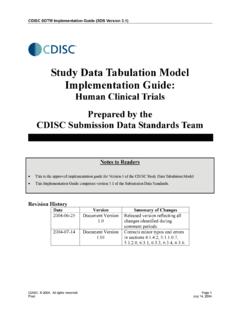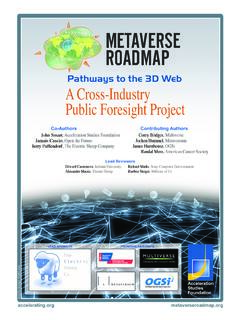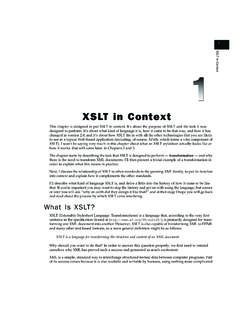Transcription of Experiences with JSON and XML Transformations - …
1 Copyright IBM 1 Experiences with json and XML TransformationsIBM Submission to W3C Workshop on Data and Services IntegrationOctober 20-21 2011, Bedford, MA, USA21 October 2011 John Boyer, Sandy Gao, Susan Malaika, Michael Maximilien, Rich Salz, Jerome SimeonFeedback to: IBM 2 Agenda Why Do We Want to Transform Friendliness vs Grotesqueness (Unfriendliness) Typical json and XML Mapping Issues Round-Trippability Friendliness A Use Case Mapping Approaches Overview of Approaches 1-4 Recommendations Ideas Some Published Mappings and References The Grand FinaleCopyright IBM 3 Why Do We Want To Transform? Trend:Javascript/Web dominates for: Fast parsing of message content Programmer convenience Trend:Multiple message formats (Atom, XML, json , etc) are becoming common XML APIs and REST APIs are being extended to support json Trend:Enterprises desire validation, declarative constraints and stringency for data content, but also want the benefits of Web Customer demand for.
2 Constraint and query features provided by XML Programming ease provided by json Copyright IBM 4 Some Data and Metadata StandardsJavaScript --JAQL, JSONiq- json is a serialized format, there are XML representations of json too-- json Schema -IETFJSONRDFa (W3C) can be used to annotate XMLMany kinds of annotations are defined for XML schemas and for XML dataNot part of the relational modelAnnotationsRIF (W3C)-Relational triggersTriggersRDF Graphs (W3C)XML Collection Function (W3C)Table, View, Database (ISO)CollectionSPARQL Graph Store HTTP Protocol for CRUD (W3C)Various, includes some of the relational APIs and specific APIs, , XQJMany for various programming languages, , JDBC, ODBC Query & CRUD APIs- xslt (XML to text, includes XML); XFormsSQL XMLTABLE (XML to relational)SQL (Tables to Tables)Transformation & Other LanguagesSPARQL (W3C)XPath, XQuery (W3C) and others for CRUD Data Manipulation Language (DML), SQL, SQL/XML (ISO)Query & CRUD LanguagesXML, TurtleXML is a syntax widely used for data exchange (W3C)SQL standard (ISO) defines an XML serialization but it is not widely used There is no agreed json serialization.
3 There are RDF Exchange SerializationsSchematron (ISO), Relax-NG (OASIS)Integrity Constraints in table definitions (ISO)ConstraintsRDFS (RDF Schema), Ontology (W3C and elsewhere)XML Schema XSD (W3C) , Namespaces (W3C)Data Definition Language (ISO)MetadataLinked DataXMLR elationalCurrently, the role of json is mainly for data exchange between JavaScript clients and servers Some XML communities who work on query and transformation languages are reviewing the idea of XML languages supporting JSONC opyright IBM 5 Friendly XML Friendly XML has multiple unique paths (multiple element and attribute names) in the XML, rather than a name value pair design Friendliness provides Easy XML consumption by programmers, authors and software Straightforward transforms, queries, and indexing capabilities<location> <city>Armonk</city> <state>NY</state> </location>Friendly XML ExampleUnFriendly XML Example<root type="object > <item name= city value= Armonk /> <item name = state value = NY /> </root>Copyright IBM 6 Friendly json Friendly json does not include repeating variable names Data types are directly associated with each variable Friendliness provides easy data structure consumption by JavaScript programmers, authors{"person": {"age": "40","name": "John Smith"}}Friendly json Example{ "book" : { "children :[{ "title" : { "attributes" : { "isbn": "15115115" },"children" : [ "This book is ", { "emph".]]}}}}}
4 "bold" }] } }] } }UnFriendly json ExampleCopyright IBM 7 Typical json and XML Mapping Issues Round-trip Transformations are challenging XML to json to XML json to XML to json General issues Different character mapping for names and values in json and XML Mismatch in data types between json and XML Semantic infidelity XML to json issues Losing XML namespaces Incorrectly mapping XML repeating elements Mishandling of relative URLs json to XML issues Incorrectly mapping json arrays Associating variables with data types in JSONC opyright IBM 8 Round-trip Why is round-tripping important? Data and data type information has to be preserved Fidelity, to prevent data loss Preservation of metadata, order Maintain usability regardless of format Some details are unnecessary, depending on use cases May not help Friendliness Copyright IBM 9 Mapping Approach OverviewFriendlyXMLM apperAArbitraryJSONA pproach 1 json to XMLF ocus on FriendlinessApproach 2 json to XML Focus on Round-TrippingArbitraryJSONM apperBXMLA pproach 3 XML to json Focus on friendlinessApproach 4 XML to json Focus on Round-TrippingArbitraryXMLM apperCFriendlyJSONM apperC Possibly different XML[ ][ ][ ][ ][ ][ ][ ][ ][ ][ ][ ]ArbitraryXMLM apperD[ ][ ] json [ ][ ][ ]Only round trip when needed with degraded friendlinessExample: JSONx at IETFC opyright IBM 10 Friendly and Round-TrippableSummary A json -to-XML mapping is friendly when the generated XML has meaningful element and attribute names, rather than a name value pair design.
5 An XML-to- json mapping is friendly when the generated json has flat structure, making it easy for JavaScript programmers to consume it. A json -to-XML mapping is round-trippablewhen the generated XML contains all the information that was in the original json , without any loss. An XML-to- json mapping is round-trippablewhen the generated json contains all the information that was in the original XML, without any IBM 11A json XML Use CaseSOAP/XMLSOAP ApplicationsHTTP-REST/JSONJavaScript ClientsFriendly JSONJSONxFriendly XMLG atewayCopyright IBM 12 Approach #1: json to Friendly XML Requirement 1: Friendly XML processing Requirement 2: Round-trippable Rules: json names become XML element names json object members and arrays become XML elements, and Simple values become XML text content Synthesized XML 'root' element Special handling to preserve data type, kinds of emptiness, and special charactersCopyright IBM 13 Approach #1: Example{"city": "Armonk","state": "NY"}<root type="object"> <city>Armonk</city> <state>NY</state> </root>In this example, becomes Copyright IBM 14 Approach #1.
6 Special characters in names and empty namesA json name may not match an XML NCName Each illegal character is escaped with two leading underscores, a hexadecimal encoding of the character's Unicode codepoint and A trailing underscore{"var$":"value","":"generic"}<root type="object"> <var__24_>value</var__24_> <__>generic</__> </root>Copyright IBM 15 Approach #1: Simple ValuesJSON name/value pair with a simple value Generate XML element from name Store string equivalent of the simple value as content of the XML element Typed as boolean, number, string, or null{"age":43,"married":true,"address":n ull}<root type="object"> <age type="number">43</age> <married type="boolean">true</married> <address nil="true"> </address> </root>Copyright IBM 16 Approach #1: Object ValuesJSON name/value pair with a non-null object value, Generate XML element based on the name Generate child elements for each of the json name/value pairs{"address": { "street" : "123 Main St.}}
7 " }}<root type="object"> <address type="object"> <street>123 Main St.</street> </address> </root>Copyright IBM 17 Approach #1: ArraysJSON name/value pair with an array value Generate a container XML element for the array Generate one child XML element for each value in the array{"locations": ["Amsterdam", "London"],"secondary_locations": []}<root type="object"> <locations type="array"> <__>Amsterdam</__> <__>London</__> </locations> <secondary_locationstype="array"> </secondary_locations> </root>Copyright IBM 18 Approach #1: Special Characters In ValuesCharacters are copied from json except for certain conversions:<<>>&&\udddd�\ \\\\//\nNewline (0x0A)\r
\ttab(0x09)Non-XML chars(\b, \f)Omitted, or encoded as PICopyright IBM 19 Approach #2: json to XML and Back Requirement: Round-trippable Usually a name/value pair Rules: XML elements to preserve data type XML elements to preserve objects XML elements to preserve arrays XML attributes/text to preserve property namesCopyright IBM 20 Approach #2: "batters":{"batter":[{ "id": 2001, "type": "Regular" },{ "id": 2003, "type": "Blueberry" }]}.
8 < json :object name="batters"> < json :array name="batter"> < json :object> < json :number name="id">2001</ json :number> < json :string name="type">Regular</ json :string> </ json :object> < json :object> < json :number name="id">2003</ json :number> < json :string name="type">Blueberry</ json :string> </ json :object> </ json :array> </ json :object>In this example, becomes Copyright IBM 21 Approach #3: XML to Friendly json Requirement: Consumable/Friendly json Requirement: Preserve XML structure Rules: XML element or attribute names become json object names, XML children elements become json objects fields or arrays, and XML text nodes become json simple valuesCopyright IBM 22 Approach #3: Multiple Child Elements with Same NameWhen multiple child elements have the same name, use json arrays to represent those elements.<people> <person> <name>John Smith</name> <age>40</age> </person> <person> <name>Jane Foster</name> <age>43</age> </person> </people>{ "people": {"person": [{"age": "40","name": "John Smith"},{"age": "43","name": "Jane Foster"}]}}Copyright IBM 23 Approach #3: Attributes and Element NodesPreserve XML notion of attributes <title isbn="15115115">This book is on XML and json </title>{"title": {"@isbn": "15115115","text()": "This book is on XML and json "}}Copyright IBM 24 Approach #3: Text Nodes and Mixed ContentAn XML element could contain both child elements and text<name>John<br/>Smith</name>{"name": {"br": {},"text()": "JohnSmith"}}Copyright IBM 25 Approach #3: Handling Document OrderPreserve document order with json array<name>John<br/>Smith</name>{"name": ["br": {},"text()": "JohnSmith"]}Copyright IBM 26 Approach #3: XML NamespacesJSON does not support a name-scoping mechanism Confuses Round-tripping, Stops being friendly json <n.
9 Root xmlns:n=\"foo\" xmlns:l=\"bar\" l:att=\"1\"> <n:node/> </n:root>{ "foo": {"root": {"bar": {"@att": "1"},"foo": {"node": {}}}}}Copyright IBM 27 Approach #3: Simple Values and DatatypesMay be necessary to keep track of the original XML type annotation<year xsi:type="xs:positiveInteger">1989</year>{ "xsi:type" : "xs:positiveInteger", value : 1989 }Copyright IBM 28 Approach #4: XML to json and Back Requirement: Round-trippable Rules: Elements are mapped as json objects with its qualified name as a field Attributes of XML elements are included as a json attributes object Element children are included as an array to preserve the original order of the element's childrenCopyright IBM 29 Approach #4: <book> <title isbn=\"15115115\">This book is <emph>bold</emph> </title> </book>..{ "book" :{ "children :[ { "title" : { "attributes" : { "isbn": "15115115" },"children" : [ "This book is ",{ "emph" : "bold" } ] } } ] } }In this example, becomes Copyright IBM 30 Mapping Approach Recommendations Use Approach 1 when your highest priority is to make the resulting XML easy to consume and then optionally round-trippable Use Approach 2 when your priority is round-trippable conversions Use Approach 3 when your highest priority to make the resulting json easily consumable and then round-trippable Use Approach 4 when your priority is not json consumption, but still capable of round-trip conversionsCopyright IBM 31 Ideas and Discussion Provide structured guidance to the W3C xslt and other groups that are looking at integrating json and XML ?
10 Provide guidance for architects and developers who create APIs and formats which apply to both json and XML ? Review the OData json proposals ? (Contains json representation for ATOM )Copyright IBM 32 Another Idea - Consider creating a W3C REST Community?Topics could include: (1) Identify gaps , WADL or similar? URL Query? Expressing REST API results ( , RDF; json ; XML; ATOM) and paging ? json Schema (2) Create Best Practices , REST CRUD (use of POST as alternative) ; POST CREATE only or TUNNEL anything ; Partial update via POST instead of PATCH Retrieve subset a resource from POST Resource Links / ATOM - HREF and REL ; <atom:link rel='..' href='..'/> ; <machine rel='..' href='..'/> URI opaqueness MIME Types Generic MIME -> Generic Tooling ; Specific MIME class -> Specific Tooling Important for json - no guarantee there will be "Root Element (outer element) ; if MIME TYPE json /XML don't know anything Copyright IBM 33 Examples from CWMG(Cloud Management Work Group at DMTF) Modeling collections : Update collections Allowable operations on a class of resources : <operation url='xxx' rel='xxx'/> <operation url="/foo" rel="stop'/> Async processing What does client do after 202 ?


















